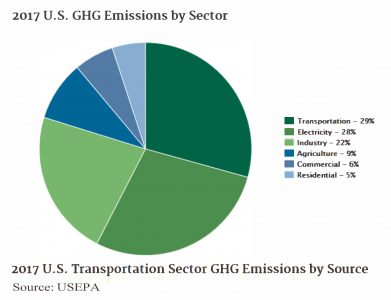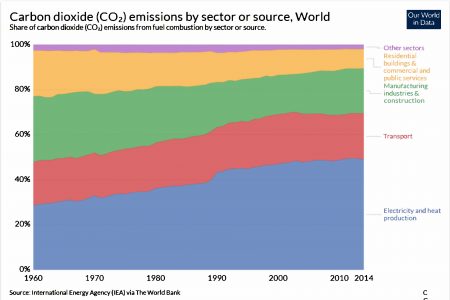“The industrial age of energy and transportation will be over by 2030. Maybe before.” Tony Seba, Clean Disruption of Energy and Transportation
Is it possible that a transformation to sustainable energy and transportation systems is right around the corner?
According to the U.S. Environmental Protection Agency, in 2017 the transportation sector accounted for the largest portion of U.S. greenhouse gas (GHG) emissions, at 29%. Electricity generation was a close second at 28%.
 Internationally, transport accounts for about 20% of global GHG emissions however globally emissions are on the rise as increases in passenger and freight volumes are growing and are expected to continue to grow through 2050.
Internationally, transport accounts for about 20% of global GHG emissions however globally emissions are on the rise as increases in passenger and freight volumes are growing and are expected to continue to grow through 2050.
So transportation is a significant contributing source of GHG and is projected to grow at a time when the world must do all we can to stop GHG emissions and reduce atmospheric concentrations well below current levels. In October 2018, the Washington Post published a story on a recent Intergovernmental Panel on Climate Change report that humanity has about a decade to make drastic changes to reduce GHG emissions before the climate reaches cascading tipping points beyond which our current way of life would not be possible.
Something has to happen.
Enter Tony Seba, Silicon Valley entrepreneur and instructor in Entrepreneurship, Disruption and Clean Energy at Stanford University’s Continuing Studies Program. He is convinced we are on the cusp of what he calls a “clean disruption of energy and transportation,” which is the title of the book he wrote in 2014. You can watch a talk Seba gave on this subject in 2018 in Boulder, CO.
 He presents a compelling case. Regarding automobile transportation specifically here are just a few of his observations and predictions:
He presents a compelling case. Regarding automobile transportation specifically here are just a few of his observations and predictions:
- Electric vehicles (EVs), ride-sharing, and autonomous vehicles mean that the world of everyday auto transportation will look entirely different in ten years.
- Electric vehicles are 5x more energy efficient than those powered by internal combustion engines (ICE); 10x cheaper to “fill up”; 10x cheaper to maintain.
- EVs will contribute to grid storage of electricity.
- Individual ownership of autos will plummet.
- By 2025, ICE vehicles will no longer be competitive with EVs.
Seba explains that cell phones, personal computers, and the Internet started as distinct products serving different markets. Their unforeseen complementary natures became interwoven and accelerated mutual adoption in society and together they transformed the world. Mostly for the better.
In the same way, according to Seba, solar energy, electric vehicles, and self-driving cars are disruptive technologies that will interweave to exponentially amplify each other and completely change auto transportation – and energy production – to be much more sustainable across society, including making transportation more affordable for everyone. Within the next ten years.
Of course, Seba has much more to say and goes into significantly more interesting and promising detail in his book and lectures. And because this column is about transportation I am not going to address what he has to say about the near-term transformation of the energy market away from coal, oil, natural gas, biofuels, and nuclear, and the rapid widespread adoption of solar, wind, and other renewables.
All of this is driven by market forces, not government regulation.
Seba’s book leaves unaddressed long-haul trucking, ocean freight, and air travel, which have significant GHG impacts. But the prospects he does describe are credible, exciting, and heartening, some much-needed positive forecasting during a particularly dark time on the sustainability front when so many trends are headed the wrong way, and amplified by wrong-headed policies at the federal level.
And let’s be clear: market forces alone will not save us.
We need thoughtful policies and programs coordinated at every level of government, nationally and internationally on our interconnected world, to solve the planetary emergency of climate change and the social, economic, and environmental crises related to it. Which means we need policy makers who represent the public interest and the common good. Which means electing policy makers who serve the common good.
We need a social contract with each other to act from our common humanity and our shared values, working across difference using the processes of deliberative democracy to envision our desired future and commit to creating it.
Change can happen quickly, for better or for worse. If change emerges from our shared values and commitment to the common good then the future holds great promise. Which is why it is essential that we stay engaged over the long term, inspired by our “better angels,” laser-focused on achieving the outcomes we want, and nothing less.





I’m all for electric vehicles once they are able to offer longer ranges and advanced towing capabilities. Trucks may be the outlier down the road.
Seba’s predictions are encouraging. But far too many Americans as of 2019 are still simply out of touch (uninformed, often by choice) with the severity of climate change. Education appears to be unsuccessful in moving our society to a tipping point. “Hoping” is insufficient.